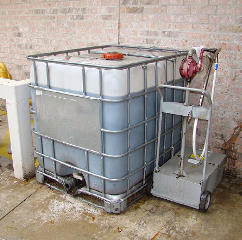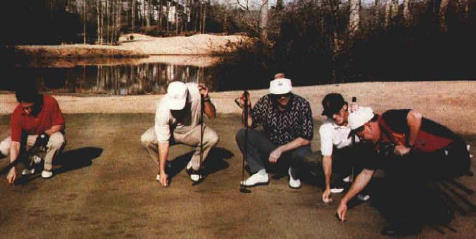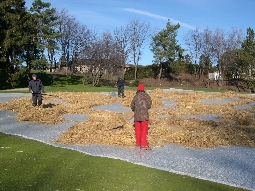The USGA Green Section
Record |
|
|
|
|
December 03, 2010 -- Volume 48, Number 25 |
|
|
Bio-Diesel | |
Going green can have multiple benefits
A guest article by Morris Johnson, director of Golf Course Operations, River Oaks CC, Houston, Texas |
 | | The used cooking oil storage tank is located at the clubhouse. A pallet tank works well in this instance. |
In 2005, River Oaks Country Club (Houston, Texas) began to refocus its efforts reducing its environmental footprint. A retrofit of the club's lighting system yielded favorable results, and a major clubhouse renovation that year included the implementation of many energy-saving systems. In 2008, the club began a recycling program in all departments, and that same year, Joe Bendy, general manager, requested the golf course operations department to research the possibility of converting the club's used cooking oil into bio-diesel fuel. For years, the club had paid to have the waste oil removed, and with some companies paying for used oil, it was determined that an even better solution would be to convert the used oil to bio-diesel.
After considerable research we soon realized that few clubs in Texas were making bio-diesel - yet the process seemed fairly simple. After speaking to various companies about the equipment and process, we selected Evolution Bio-diesel in Huntsville, Texas. They make conversion machines in different sizes and are very user friendly. The last thing we wanted was a complicated and time-consuming process that taxed our already busy maintenance department. Having done considerable research on the process, our equipment manager, Gavin Williams, undertook the project with enthusiasm. Read on to see how this project turned out.
|
| Recycling Efforts Ring the Cash Register for Wildhorse Golf Club | |
Practicing environmental stewardship results in more money in the bank for this southern Nevada golf course
by Brian Whitlark, agronomist, Southwest Region |
 | | General Manager Andy Wright peers into the recycling bin containing food scrapes and waste from food and beverage operations at the club. Not only is the recycling reducing the impact on the environment, it is saving the club from $100 to more than $1500 per month, depending on the season. |
Green is good! That is true, especially for the Wildhorse Golf Club, located in Henderson, Nevada, where the grass is green, the course has embraced the green movement, and recycling efforts are saving the almighty green dollar. Wildhorse has been certified by the Audubon Cooperative Sanctuary Program (ACSP) since May 2008. "Because of our relationship with the ACSP and our commitment to set an example for environmental stewardship in the community, it just made good sense to implement a comprehensive recycling program," says Andy Wright, general manager.
The club began collecting cans and bottles and eventually expanded the program to include cardboard, paper products, and even green waste and food scraps. Green waste generated from golf maintenance operations was initially mulched and composted; however, the Southern Nevada Health Department shut the process down, citing that the club needed a permit to conduct such operations. The green waste is now disposed of in a 40-yard dumpster and hauled off by a local landscape and maintenance company. The material is sorted, separated, and hauled to an organic composting facility, where it is mulched, composted, and later sold as fertilizer. Scott Sutton, golf course superintendent, noted that the green material used to amount to four or five loads per month at a price of $480 per load. Once the club purchased a wood chipper, the load frequency decreased to only once or twice per month, saving the club about $1,500 each month during the growing season. The scope of the recycling program does not stop there. Read how this club makes recycling work.
|
| A Green Section Video - Ball Marks On Putting Greens | Green firmness and proper repair technique are crucial
by Adam Moeller, agronomist, Northeast Region | |
 Ball marks are a problem for almost every club. This eight minute video illustrates proper repair technique and summarizes Purdue University research on the topic. Ball marks are a problem for almost every club. This eight minute video illustrates proper repair technique and summarizes Purdue University research on the topic.
Watch the movie on your PC
Watch the movie on your IPhone
|
| Conference Season Is Here! | |
 A Mid-Continent Regional Update A Mid-Continent Regional Update
by Ty McClellan, agronomist | |
Frost has arrived, evoking a collective sigh of relief from turf managers and cool season turfgrasses alike. For most, cool weather (and even snowfall) has been but a dream since early July when Mother Nature began punishing cool season turfgrasses throughout the Mid-Continent Region, and much of the country for that matter.
As a grueling year comes to a close, conference season moves into full swing and all indications are that meetings will be well attended. Recently, the Central Illinois GCSA enjoyed an audience larger than in recent years at their Annual Education Seminar. The demands brought forth by Mother Nature this summer didn't allow superintendents much, if any, time away from the golf course. Poor attendance at golf course superintendent chapter meetings resulted, but this should change now with the opportunity to gather for education and camaraderie at a time of year when golf courses are on the mend.
Appropriately, many of the conferences this winter will feature education targeted towards summer survival strategies for cool season turfgrasses. Given the recent environmental challenges, combined with persisting economic limitations, it would be well worth inviting a course official to attend a conference with you.
To learn more about conferences in your area, contact your local superintendent association or USGA Green Section office. Follow this link to see the upcoming conferences for the upper Mid-Continent Region.
|
| The Transition From Fall To Winter | |
 A Northeast Regional Update A Northeast Regional Update
by Jim Skorulski, senior agronomist |
 | | The staff at Hillsdale Golf and Country Club in Mirabel, Quebec spreads straw that insulates the putting green turf from lethal temperatures in winter. Timing the installation of the cover systems is done as late as possible in fall to allow the turf an opportunity to gain cold temperature hardiness before being covered. |
The first day of December brought heavy rain and warm temperatures to much of the region. The weather event, though short lived, illustrates the challenges turfgrass managers face as the season transitions from fall to winter. Wide temperature fluctuations and rain can impact the winter acclimation process and complicate management decisions. Weather impacts are probably greatest in northern parts of the region where the transition window is often short and less predictable. Managers use long-range weather forecasts and rely on their intuition to time winter fungicide applications and install covers. Push the envelope too late and you might find a permanent blanket of snow in your way. Move too early and take the risk of a fungicide failure or poor success with winter covers. The turf's condition in spring can often be linked to the weather conditions that occur during this transitional period. Read the rest of this update.
|
| The Gifts Of Time - TAS And Apps For Your IPhone | |
 A North-Central Regional Update A North-Central Regional Update
by Bob Brame, director | |
Little by little the lower North Central Region is pulling out of the drought that extends back to midsummer, although we still have a ways to go. For example, the Cincinnati area is still close to five inches down on annual rainfall. Check out the attached link from Dr. Aaron Patton at Purdue University if drought - related questions continue to impact your maintenance operation. http://www.agry.purdue.edu/turf/tips/2010/11152010_latedrought.html.
Advance preparation goes a long way towards determining the impact that harsh weather will have. So is your maintenance operation ready for the next stint of less-than-ideally-timed harsh weather? We stand ready to review and advise based on current research and field observations.
We've received several phone calls about the EPA action on PCNB and there have been multiple postings on the topic over the last few weeks. Joe Rimelspach at Ohio State University also has offered some thoughts that are worth reviewing - http://buckeyeturf.osu.edu/component/option,com_intsportsnotes/Itemid,85/noteid,2491.
Do you carry an iPhone? Now is a great time to review some of the apps, available from Apple - http://www.apple.com/iphone/apps-for-iphone/, that can aid golf turf management.
See the apps and read the rest of this update.
|
| Early Winter Course Conditions In Florida | |
 A Florida Regional Update A Florida Regional Update
by John Foy, director | |
Golfers from the North started returning to Florida in October, and by Thanksgiving many clubs had hosted official season-opening events. There is always a progressive increase in play during October and November, but, unfortunately, both private and public facilities are reporting that the number of golf rounds continue to be down 10% to 20% compared to pre-recession numbers. It is hard to be optimistic when faced with another season of reduced golf revenues.
Similar to the rest of the eastern two-thirds of the country, record-setting high temperatures were experienced throughout the Florida summer. However, bermudagrasses and seashore paspalum have very good high temperature tolerance, so extensive turfgrass damage and loss was not a problem. The drier weather pattern that has prevailed during the late summer and fall has limited the usual extended periods of heavy cloud cover, and the abundant sunshine has directly benefited the health and quality of bermudagrass. During TAS visits in the central and southern part of the state, good quality and appropriate overall course conditioning is being provided and enjoyed by the early winter season golfers.
Read the rest of this update.
|
| Green Section Record Archive (digital) | Looking for a previous issue of the Green Section Record?
|
 | |
Looking for something? |
The Green Section Record has been published under various names since 1921 and is composed of an amazing collection of full-text articles and photos. This collection is stored and maintained by the wonderful library staff at Michigan State University in the Turfgrass Information File (TGIF). All past issues of the Record, right up to and including this one, can be accessed free of charge by following this link. Search the Green Section Record |
| The USGA Green Section Portal |
A Valuable Resource For All, And It's Free |
Take a minute to visit the Green Section's portal at http://gsportal.usga.org to find information regarding upcoming live webcasts and links to recordings of more than 30 previously-delivered webcasts, and announcements of upcoming USGA Green Section activities, education conferences, and meetings. |
|
|
|
| USGA Green Section
P.O. Box 708
Far Hills, NJ 07931-0708 908.234.2300
| |

©2010 by United States Golf Association®
Permission to reproduce articles or material in the USGA Green Section Record is
granted to newspapers, periodicals, and educational institutions (unless specifically
noted otherwise). Credit must be given to the author, the article's title, USGA Green
Section Record, and the issue's date. Copyright protection must be afforded. To reprint
material in other media, written permission must be obtained from the USGA. In any
case, neither articles nor other material may be copied or used for any advertising
promotion, or commercial purposes.
Green Section Record (ISSN 2156-5813) is published weekly via electronic mail by the
United States Golf Association®, Golf House, Far Hills, NJ 07931.
|
|
|
|
|
|